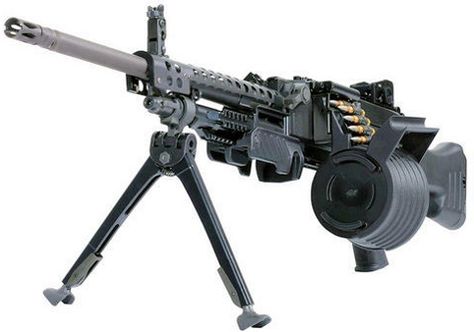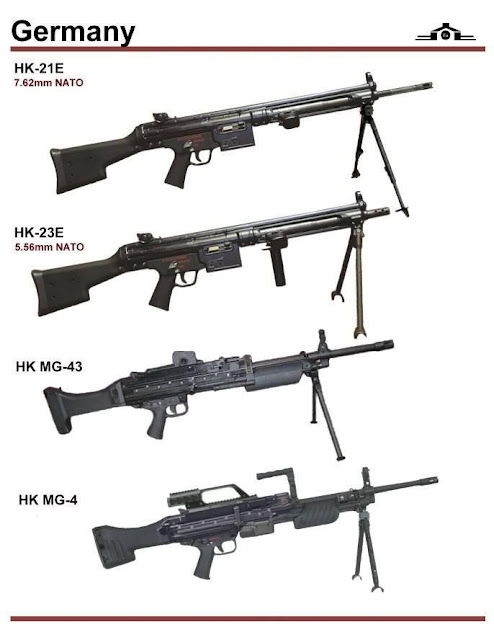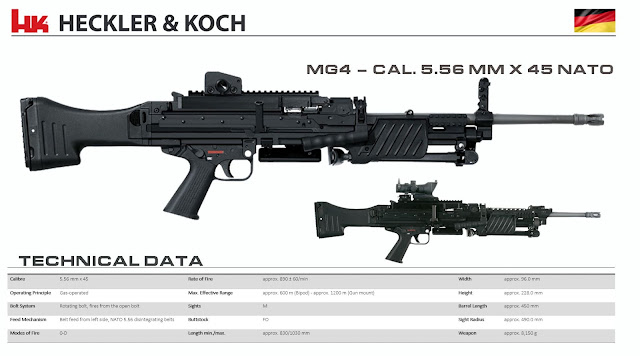La MG4 è una mitragliatrice leggera progettata e sviluppata dalla società tedesca Heckler & Koch. La mitragliatrice era inizialmente conosciuta come MG43 prima della sua adozione da parte della Bundeswehr.
La Heckler & Koch MG4 (nota anche come HK123 ) è una mitragliatrice leggera da 5,56 mm alimentata a cinghia progettata e sviluppata dal produttore tedesco di armi da fuoco Heckler & Koch. L'arma è stata sviluppata alla fine degli anni '90 ed è stata vista pubblicamente per la prima volta nel settembre 2001. È stata selezionata per sostituire la mitragliatrice per uso generale MG3 da 7,62 mm nella Bundeswehr a livello di supporto di squadra; completerà l'MG3 in altri ruoli. L'MG4 sarà anche l'armamento secondario del nuovo Puma veicolo da combattimento di fanteria. Nel complesso, è progettato per essere leggero, fornire la massima sicurezza all'utente e funzionare in modo affidabile in condizioni avverse utilizzando un'ampia gamma di munizioni di diversi produttori, senza la necessità di regolare il sistema del gas. La mitragliatrice era inizialmente conosciuta come MG43 prima della sua adozione da parte della Bundeswehr.
Dettagli del design
L'MG4 è una mitragliatrice leggera a gas raffreddata ad aria, alimentata a cinghia con un otturatore rotante bloccato positivamente ed è in qualche modo simile nel concetto alla mitragliatrice leggera Belga Minimi. I meccanismi di sicurezza sulla mitragliatrice includono una sicurezza manuale incorporata nel selettore della modalità di fuoco; impostando la leva selettrice in posizione "sicura" si blocca meccanicamente il grilletto e si blocca l'otturatore in posizione armata. Quando l'otturatore non viene ritirato completamente, lo sparo accidentale è impedito da un meccanismo automatico integrato che impedisce all'otturatore di spostarsi in avanti. Inoltre, il percussore non può raggiungere il primer della cartuccia finché la cartuccia non è stata completamente camerata.
La mitragliatrice è alimentata da un nastro disintegrabile e viene eseguita in due fasi dall'alto a sinistra utilizzando un meccanismo a nottolino potenziato. Come sulla famiglia di mitragliatrici MG42, le maglie vengono espulsa a destra ed i bossoli vengono espulsi verso il basso, sebbene l'espulsione laterale a destra sia un'opzione.
L'MG4 ha una canna a cambio rapido forgiata a martello che può essere sostituita in sicurezza a caldo senza la necessità di guanti protettivi; la maniglia di trasporto funge da presa per il cambio della canna. Il gruppo della canna pesa 1,80 kg (3,97 libbre). Per ridurre la lunghezza complessiva dell'arma per il trasporto, il calcio può essere piegato sul lato sinistro del ricevitore. Con il calcio piegato, l'MG4 rimane completamente utilizzabile. Un kit per la pulizia del campo è contenuto nel calciolo. L'MG4 tiene conto dello spostamento zero tra il gruppo otturatore rendendo la vista frontale dei gruppi regolabile meccanicamente. Nella sua forma standard, l'MG4 è dotata di mirini in ferro di tipo chiuso con impostazioni di portata fino a 1.000 m (1.094 yd) in 100 m (109 yd) incrementali. L'elemento del mirino pieghevole è montato sul gruppo della canna ed è regolabile meccanicamente sia in deriva che in elevazione. Il raggio della linea di mira è di 602 millimetri (23,7 pollici). Mirini ottici o notturni o puntatori laser possono essere montati su una lunghezza della guida Picatinny MIL-STD-1913 situata sul coperchio del serbatoio di alimentazione del ricevitore. I modelli della Bundeswehr sono dotati di mirini telescopici con ingrandimento 3 ×.
Viene fornito un bipiede pieghevole del peso di 0,70 kg (1,54 libbre). Le interfacce di supporto sono integrate nel ricevitore per consentire a MG4 di essere montato sul treppiede USA standard M122A1 per una maggiore precisione e stabilità.
Varianti
MG4 (HK123)
La mitragliatrice leggera Heckler & Koch MG4 (HK123) è camerata in una cartuccia NATO da 5,56 × 45 mm ed è stata adottata dalla Bundeswehr.
MG4E (HK123E)
Una variante di esportazione dell'MG4 è stata leggermente modificata ed è leggermente più leggera. La lettera "E" nella designazione sta per "Export". Ha un gruppo a recupero di gas diverso che riduce la velocità di fuoco ciclica. Nel 2007, l'esercito spagnolo ha adottato questa variante come mitragliatrice leggera standard. L'esercito spagnolo ha ordinato 1.800-2.000 di queste mitragliatrici leggere.
Arma da veicolo MG4 (arma da veicolo HK123)
Una variante dell'MG4 è configurata per l'uso come veicolo o mitragliatrice coassiale. Manca un calcio, tacca di mira, deflettore del bossolo, paramano e supporto per bipiede. Può essere dotata di dispositivo di sparo a distanza e leva selettrice di sicurezza / fuoco. Può anche essere montata per uso manuale.
MG4K (HK123K)
E’ una variante dell'MG4 con una canna più corta.
MG4KE (HK123KE)
Una variante da esportazione dell’MG4K.
MG4 A3
Una variante modernizzata dell'esercito tedesco in fase di test che introduce elementi Heckler & Koch MG5 come l'ottica Hensoldt ZO 4 × 30 Intermediate Targeting Optic combinata con un punto rosso come mirino ottico diurno con ingrandimento 4 × per promuovere la precisione del fuoco. Come l'MG5, l'MG4 A3 utilizza una finitura superficiale marrone-verde RAL 8000.
Derivata MG5 (HK121)
La mitragliatrice per uso generale Heckler & Koch MG5 (HK121) è camerata per una cartuccia NATO da 7,62 × 51 mm. È stata adottata dalla Bundeswehr come mitragliatrice standard per uso generale. L'MG5 è fortemente basata sull'MG4, tuttavia ci sono solo poche parti intercambiabili a causa delle mitragliatrici che hanno calibri diversi e delle loro differenze di dimensioni.
Utenti:
- Albania : arma di supporto leggero standard delle Forze albanesi;
- Brasile : uso limitato sull'esercito brasiliano ;
- Estonia : utilizzato da ESTSOF.
- Germania : arma standard di supporto a livello di plotone dell'esercito tedesco, adottata nel 2005 ;
- Malaysia : Utilizzato dalla tattica delle forze speciali PASKAL della Royal Malaysian Navy, adottato nel 2006.
- Portogallo
- Spagna : ordinate 1.800-2.000 mitragliatrici MG4E nel 2007 e le consegne dovrebbero continuare nei prossimi quattro anni. LMG standard per l' esercito spagnolo, di solito dotata di mirino ACOG .
- Turchia Air Force MAK SF;
- Mitragliatrice leggera standard dell'Arabia Saudita.
Curiosità
L'MG4 compare nei videogiochi Call of Duty: Modern Warfare 2 e Battlefield 4
ENGLISH
The Heckler & Koch MG4 (also known as the HK123) is a belt-fed 5.56 mm light machine gun designed and developed by German firearm manufacturer Heckler & Koch. The weapon was developed in the late 1990s and was first seen publicly in September 2001. It has been selected to replace the 7.62 mm MG3 general-purpose machine gun in the Bundeswehr at the squad support level; it will complement the MG3 in other roles. The MG4 will also be the secondary armament of the new Puma infantry fighting vehicle. Overall, it is designed to be light, provide maximum safety to the user and function reliably under adverse conditions using a wide range of ammunition from different manufacturers, without the need to adjust the gas system. The machine gun was initially known as the MG43 prior to its adoption by the Bundeswehr.
Design details
The MG4 is an air-cooled, belt-fed gas-operated light machine gun with a positively locked rotary bolt and is somewhat similar in concept to the Belgian Minimi light machine gun. Safety mechanisms on the machine gun includes a manual safety incorporated into the fire mode selector toggle; setting the fire selector lever on the "safe" position blocks the trigger mechanically and locks the bolt in the cocked position. When the bolt is not pulled back completely, accidental firing is prevented by an integral, automatic mechanism that prevents the bolt from traveling forward. In addition, the firing pin cannot reach the cartridge primer until the cartridge has been fully chambered.
The machine gun is fed from a disintegrating belt and is carried out in two stages from the top left using an enhanced pawl mechanism. As on the MG42 family of machine guns, the belt is expelled to the right and spent cases are ejected downwards, although sideways ejection to the right is an option.
The MG4 has a hammer-forged quick-change barrel that can be safely exchanged when hot without the need for protective gloves; the carrying handle serves as the barrel change grip. The barrel assembly weighs 1.80 kg (3.97 lb). To reduce the overall length of the weapon for transport, the butt stock can be folded to the left side of the receiver. With the buttstock folded the MG4 remains fully operable. A field cleaning kit is housed within the stock. The MG4 takes zero shifts between barrel assemblies into account by making the front sight of the assemblies mechanically adjustable. In its standard form, the MG4 is equipped with closed type iron sights with range settings up to 1,000 m (1,094 yd) in 100 m (109 yd) increments. The folding front sight element is mounted on the barrel assembly and is adjustable mechanically for both windage and elevation. The sight line radius is 602 millimeters (23.7 in). Optical or night sights or laser pointers can be mounted on a length of MIL-STD-1913 Picatinny rail located on the receiver feed tray cover. Bundeswehr models are equipped with telescopic sights with 3× magnification.
A folding bipod weighing 0.70 kg (1.54 lb) is provided. Supporting interfaces are integrated into the receiver to allow the MG4 to be mounted on the standard American M122A1 tripod for increased accuracy and stability.
Variants
MG4 (HK123)
The Heckler & Koch MG4 (HK123) light machine gun is chambered in 5.56×45mm NATO cartridge and has been adopted by the Bundeswehr.
MG4E (HK123E)
An export variant of the MG4 that has been slightly modified and is slightly lighter. The letter "E" in the designation stands for "Export". It has a different gas assembly that reduces the cyclic rate of fire. In 2007, the Spanish Army adopted this variant as their standard light machine gun. The Spanish Military of Defence ordered 1,800–2,000 of these light machine guns.
MG4 Vehicle Weapon (HK123 Vehicle Weapon)
A variant of the MG4 configured for use as a vehicle or coaxial machine gun. It lacks a buttstock, rear sight, cartridge case deflector, handguard, and bipod mount. It can be fitted with a remote firing device and safety/fire selector lever. It can also be fitted for dismounted use.
MG4K (HK123K)
A variant of the MG4 with a shorter barrel.
MG4KE (HK123KE)
An export variant of the MG4K.
MG4 A3
A German Army modernized variant under test that introduces Heckler & Koch MG5 elements such as being fitted with the Hensoldt ZO 4×30 Intermediate Range Targeting Optic combined with a red dot as optical day sights with 4× magnification to promote accuracy of fire. Like the MG5 the MG4 A3 uses a RAL 8000 green brown surface finish.
MG5 (HK121) derivative
The Heckler & Koch MG5 (HK121) general-purpose machine gun is chambered in 7.62×51mm NATO cartridge. It has been adopted by the Bundeswehr as their standard general-purpose machine gun. The MG5 is heavily based on the MG4, however there are only few parts that are interchangeable due to the machine guns having different calibers and their size differences.
(Web, Google, Wikipedia, You Tube)




























































